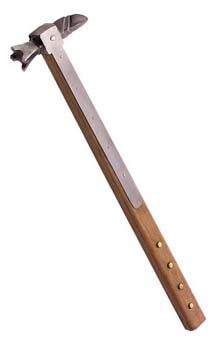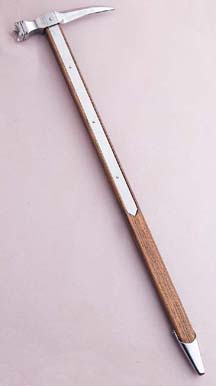Difference between revisions of "War hammer"
m |
m |
||
| Line 25: | Line 25: | ||
A war hammer is an archaic weapon of war intended for close combat, the design of which resembles the hammer. The war hammer consists of, like the tool it resembles, a handle and a head. The handle may be of different lengths, the longest being roughly equivalent to the halberd, and the shortest about the same as a mace. Long war hammers were pole weapons (polearms) meant for use against riders, whereas short ones were used in closer quarters and from horseback. Later war hammers often had a spike on one side of the head, thus making it a more versatile weapon. War hammers were developed as a consequence of the ever more prevalent metal armours of the medieval battlefields during the 14th and 15th centuries. The war hammer could deal blows of tremendous force to the target, especially when mounted on a pole, and by impact alone do damage without penetrating the armour. The spike end could be used for grappling the target's armour, reins, or shield, or could be turned in the direction of the blow to pierce even heavy armour. Against mounted opponents, the weapon could also be directed at the legs of the horse, toppling the armored foe to the ground where he could be more easily attacked. | A war hammer is an archaic weapon of war intended for close combat, the design of which resembles the hammer. The war hammer consists of, like the tool it resembles, a handle and a head. The handle may be of different lengths, the longest being roughly equivalent to the halberd, and the shortest about the same as a mace. Long war hammers were pole weapons (polearms) meant for use against riders, whereas short ones were used in closer quarters and from horseback. Later war hammers often had a spike on one side of the head, thus making it a more versatile weapon. War hammers were developed as a consequence of the ever more prevalent metal armours of the medieval battlefields during the 14th and 15th centuries. The war hammer could deal blows of tremendous force to the target, especially when mounted on a pole, and by impact alone do damage without penetrating the armour. The spike end could be used for grappling the target's armour, reins, or shield, or could be turned in the direction of the blow to pierce even heavy armour. Against mounted opponents, the weapon could also be directed at the legs of the horse, toppling the armored foe to the ground where he could be more easily attacked. | ||
| − | {{Wikipedia| | + | {{Wikipedia|War_hammer}} |
==Images== | ==Images== | ||
[[Image:war_hammer_2.jpg|frame|Image Source: [http://www.windlass.com Windlass Steelcrafts]|left]] | [[Image:war_hammer_2.jpg|frame|Image Source: [http://www.windlass.com Windlass Steelcrafts]|left]] | ||
[[Image:war_hammer_1.jpg|frame|Image Source: [http://www.windlass.com Windlass Steelcrafts]|left]] | [[Image:war_hammer_1.jpg|frame|Image Source: [http://www.windlass.com Windlass Steelcrafts]|left]] | ||
Revision as of 20:09, 20 May 2006
| ||||||||||||
Real-life context
A war hammer is an archaic weapon of war intended for close combat, the design of which resembles the hammer. The war hammer consists of, like the tool it resembles, a handle and a head. The handle may be of different lengths, the longest being roughly equivalent to the halberd, and the shortest about the same as a mace. Long war hammers were pole weapons (polearms) meant for use against riders, whereas short ones were used in closer quarters and from horseback. Later war hammers often had a spike on one side of the head, thus making it a more versatile weapon. War hammers were developed as a consequence of the ever more prevalent metal armours of the medieval battlefields during the 14th and 15th centuries. The war hammer could deal blows of tremendous force to the target, especially when mounted on a pole, and by impact alone do damage without penetrating the armour. The spike end could be used for grappling the target's armour, reins, or shield, or could be turned in the direction of the blow to pierce even heavy armour. Against mounted opponents, the weapon could also be directed at the legs of the horse, toppling the armored foe to the ground where he could be more easily attacked.
The above information was taken from the Wikipedia article at http://en.wikipedia.org/wiki/War_hammer.
Images

